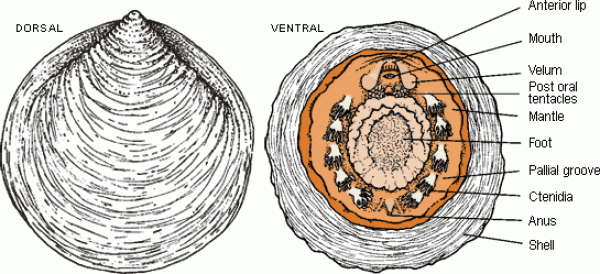Monoplacophora (Monoplacophorans)
Monoplacophora, meaning "bearing one plate", is a polyphyletic class of mollusks with a cap-like shell, living on the bottom of deep sea. Extant representatives were unknown until 1952; previously they were known only from the fossil record.
Discussion about monoplacophorans is made difficult by the slippery definition of the taxon; some authors take it to refer to all non-gastropod molluscs with a single shell, or all single-shelled molluscs with serially-repeated units; whereas other workers restrict the definition to cap-shaped forms, excluding spiral and other shapes of shell. The inclusion of the gastropod-like Bellerophontoidea within the group is also contentious.
One attempt to resolve this confusion was to separate out the predominantly coiled helcionelloids from the traditional, cap-like tergomyans, this latter group containing extant Tryblidiids.[3]Neopilina is considered as a living fossil. they have a limpet like a shell
Extant monoplacophorans live in deeper waters (175 m & deeper). Cambrian forms predominately lived in shallow seas, whereas later Paleozoic forms are more commonly found and in deeper waters with soft, muddy sea floors.[4]
In 2006 a molecular study on Laevipilina antarctica suggested that Monoplacophora and Polyplacophora form a well-supported clade with the researched Neopilina closest to the chitons. The two classes in this new clade, with the proposed name Serialia, all show a variable number of serially repeated gills and eight sets of dorsoventral pedal retractor muscles. This study contradicts the fossil evidence, which suggests that the Monoplacophora are the sister group to the remainder of the conchiferans and that the cephalopods (squid and octopus) arose from within the monoplacophoran lineage. However, some authors dispute this view and do not necessarily see modern monoplacophora as related to their fossil ancestors. The fossil record does indicate that the ancestral mollusc was monoplacophoran-like and that the polyplacophora arose from within the monoplacophora – not the other way round; this could be reconciled if a secondary loss of shells caused a monoplacophoran body form to reappear secondarily. This is plausible: modern monoplacophorans are not closely related to vent-dwelling representatives from the Silurian, at least. Cambrian monoplacophoran Knightoconus antarcticus is thought to be an ancestor to the cephalopods.
http://en.wikipedia.org/wiki/Monoplacophora | ||
Virtual museum of the Czech Geological Survey, www.geology.cz, (C) Czech Geological Survey, 2011, v.0.99 [13.12.2011]


![[ENG]](img/vlajka-cr.gif) Česky
Česky 

